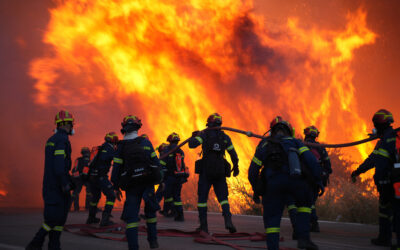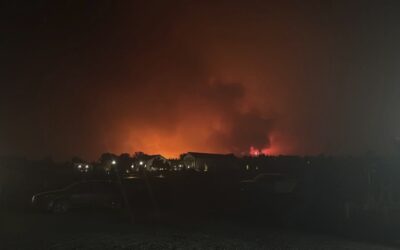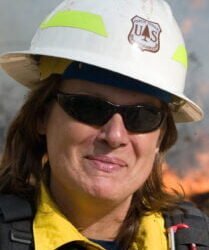HONOLULU (AP) — The wildfire that killed at least 102 people on Maui last year erupted from an earlier brushfire, sparked by downed power lines, that firefighters believed they had extinguished, officials confirmed Wednesday as they presented their findings on the cause.
The Aug. 8, 2023, blaze — the deadliest U.S. wildfire in more than a century — emerged in the afternoon in the same area as the blaze that began earlier that morning. Driven by strong, erratic winds, the fire raced through the historic town of Lahaina, destroying thousands of buildings, overcoming people trapped in their cars and forcing some residents to flee into the ocean.
It had been unclear whether the blaze was a separate fire or a rekindling of the morning fire, and whether firefighters should have left the scene after they spent hours dousing it. The answers could prove significant to questions about liability for the destruction, though a tentative $4 billion settlement has been reached.
In presenting their findings, officials with the U.S. Bureau of Alcohol, Tobacco, Firearms and Explosives and the Maui Fire Department did not address liability but found that the wildfire was clearly a rekindling of the morning fire — most likely from winds blowing an undetected ember into a dry, overgrown gully nearby.
“We deeply regret that our operations contributed to the fire that ignited in the morning,” Hawaiian Electric Co., the company whose power lines sparked the earlier fire, said in a statement Wednesday. “Confronted by an extraordinary weather event and a chaotic situation, our employees brought their best efforts to their jobs, as they do every day.”
The officials stressed that Maui firefighters had done all they could to put out the morning fire before leaving to address other calls for service on a day when other fires were burning around the island.
“They deployed countless resources, spent an extensive amount of time on the scene, and observed the scene after they believed it was extinguished,” Jonathan Blais, the ATF’s special agent in charge of the Seattle Field Division, which includes Hawaii, told a news conference. “So, yes, I do believe they did everything possible.”
While wind was the most likely cause of the fire’s rekindling, the ATF’s report said investigators could not rule out another possibility: that the operator of a bulldozer, trying to help firefighters contain the blaze, could have unwittingly pushed smoldering debris to the gully’s edge, only to have it erupt in flames hours later.
“The close proximity of the freshly cut firebreak to the western edge of the gully does not afford investigators the ability to rule out the possibility that while cutting the firebreak, the operator unknowingly moved still burning vegetation or smoldering debris into the gully,” the report said.
The owner of the company that provided the bulldozer told ATF investigators less than two weeks after the fire that he had shown up because a friend who lived nearby asked for help. The owner did not respond to several requests for a follow-up interview, the report said. Neither the owner nor members of his crew were identified in the report.
Video from inside the bulldozer showed it piling loose soil and burned vegetation at the edge of the gully, the report said.
Bulldozers driven by volunteers and contractors are frequently used to protect towns and farms from wildfires across the western U.S., though some groups have questioned their effectiveness in extreme weather conditions.
The ATF report was included as an appendix in a report from the Maui Fire Department, which asked the agency last year to help determine how the fire started. Several other agencies have also investigated the fire and the response to it, detailing the poor conditions — including emergency response missteps — that contributed to the tragic outcome.
Communication between the police and fire departments was spotty, cellphone networks were down and emergency officials did not activate the emergency sirens that might have warned residents to evacuate. Power lines and poles had fallen in many locations throughout town, and police blocked some roads to protect residents from potentially dangerous lines. First responders also had trouble getting a firm answer from Hawaiian Electric representatives if the power had been cut to the area.
The blocked roads contributed to gridlock that left fleeing people trapped in their cars as the flames advanced. Others died in their homes or outside as they tried to escape. The death toll surpassed that of the 2018 Camp Fire in northern California, which left 85 dead and destroyed the town of Paradise.
Thousands of Lahaina residents have sued various parties they believe to be at fault for the fire, including Hawaiian Electric, Maui County and the state of Hawaii. The defendants have often tried to point fingers at each other, with Hawaiian Electric saying the county shouldn’t have left the first fire unattended, and Maui County contending the electric utility failed to take proper care with the power grid. Exactly who was responsible for clearing brush and maintaining area has also been a point of contention among the defendants, along with the utility’s lack of a public safety power shut-off program.
A few days before the one-year anniversary of the wildfires, Hawaii Gov. Josh Green announced a $4 billion settlement. That’s the amount the defendants — including Hawaiian Electric, the state, Maui County, large landowners and others — have agreed to pay to settle claims.
But the deal is tied up in court, awaiting a decision from Hawaii Supreme Court on whether insurance companies can go after the defendants separately to recoup what they’ve paid to policyholders. Lawyers for people seeking compensation fear allowing insurance companies to sue Hawaiian Electric and others will subvert the deal, drain what is available to pay fire victims and lead to prolonged litigation.
Jake Lowenthal, an attorney representing people suing over fire, said the report didn’t provide any information that would change their theory of liability in the case: that firefighters left the scene, that the utility didn’t maintain their equipment or have a power shutoff program, and that some large landowners left their properties untended with dry, overgrown vegetation that provided ample fuel for the blaze.
“Every piece of additional information allows the community to continue to heal,” Lowenthal said, “and allows us to move forward with how the fire was caused and how we can continue to protect the community to make sure this doesn’t happen again.” ___
Boone reported from Boise, Idaho, and Durkin Richer from Washington.
Things to know about the investigations into the deadly wildfire that destroyed a Maui town
HONOLULU (AP) — Drought, a lack of preparation, poor communication — a handful of reports from research organizations and government agencies have detailed some of what went wrong when a catastrophic wildfire burned through the historic Maui town of Lahaina last year, killing 102 people.
Now a new report from the Maui Fire Department and the U.S. Bureau of Alcohol, Tobacco, Firearms and Explosives attempts to answer perhaps the biggest question of all: Exactly where and how did the Aug. 8, 2023, wildfire — the deadliest in the U.S. in over a century — begin?
The Maui Fire Department’s Cause and Origin report, with a summary of the ATF investigation’s findings included as an appendix, was released Wednesday. The agencies did not address liability, but both found that the fire that destroyed much of the town was a rekindling of a blaze that began earlier that morning when a broken power line hit the ground, igniting brush near a large subdivision.
Here’s what to know:
What happened leading up to the fire?
Many things went wrong before and during the disaster. In the months before, no significant steps were taken to mitigate wildfire risk, though in previous years other brush fires destroyed homes after starting in the same area. In the weeks before, the landscape went from lush to bone-dry from a flash drought.
The National Weather Service predicted high winds days in advance of the disaster, issuing a “red flag warning” on the fire danger. A forecaster even emailed fire managers an “unprecedented advance warning” on Aug. 4, 2023, of the danger that would develop four days later. Investigators reviewing the emergency response said they found “no evidence” that Hawaii officials made preparations for it.
How did the fire start?
Fire broke out near Lahaina early Aug. 8 after a live power line fell and hit overgrown brush near the edge of town. A Maui Fire Department crew responded, staying at the scene for several hours until they believed the fire was extinguished.
After they left, flames were spotted again. Firefighters rushed back, but this time they were were no match for the wind and flames.
The ATF investigators could not determine exactly how the fire rekindled but said wind was the most likely explanation. It could have rekindled from burning material blown into a gully, or the burning material could have been inadvertently pushed there by heavy equipment that was being used to create a firebreak, according to the investigation. The wind also could have simply ignited smoldering material that was initially hidden beneath dirt and ash.
Either way, the catastrophe was the result of one fire, which originated when Hawaiian Electric utility equipment failed and ignited overgrown brush, both agencies said.
What happened when people tried to evacuate?
The high winds knocked out electricity and cellphone networks went down, leaving people without phones, internet, television and radio — and no way to receive emergency alerts or reach loved ones. Police and fire crews delivered warnings door to door, but Maui County officials failed to sound emergency sirens telling residents to flee.
Many residents decided to leave on their own when they saw flames or smelled smoke. But police closed key routes out of town to protect people from downed lines toppled by the wind. Most of the traffic was routed along the same downtown street, gridlocking the town.
Meanwhile, 911 operators and emergency dispatchers were overwhelmed with calls from those able to get service.
One family made it out by swerving around a barricade blocking Honoapiilani Highway, the main coastal road leading in and out of Lahaina.
How many people died?
The Maui Police Department said 102 people between the ages of 7 and 97 died, and two more remain missing and unaccounted for. More than two-thirds of the victims were in their 60s or older. Some died in their vehicles. Others died in burning buildings or outside as they tried to flee.
Those who were close enough jumped into the ocean while others huddled behind a seawall, fighting to survive the choppy, wind-whipped waters while choking on acrid smoke and dodging flaming debris. Many of those in the ocean survived, but some bodies were recovered along the seawall and in the water.
The toll surpassed that of the 2018 Camp Fire in northern California, which left 85 dead and destroyed the town of Paradise. A century earlier, the 1918 Cloquet Fire broke out in drought-stricken northern Minnesota, destroying thousands of homes and killing hundreds.
Who has been sued?
Thousands of Lahaina residents have sued various parties they believe to be at fault for the fire, including Hawaiian Electric, Maui County and the state of Hawaii.
A few days before the one-year anniversary of the wildfires, Hawaii Gov. Josh Green announced a $4 billion settlement. That’s the amount the defendants — including Hawaiian Electric, the state, Maui County, large landowners and others — have agreed to pay to settle claims.
But the deal is tied up in court. The Hawaii Supreme Court agreed last week to weigh in on whether insurance companies can go after the defendants separately to recoup what they’ve paid to policyholders. Lawyers for people seeking compensation fear allowing insurance companies to sue Hawaiian Electric and others will subvert the deal, drain what is available to pay fire victims and lead to prolonged litigation.
If the court rules that the insurance companies do have an independent right to pursue their own suits against the same defendants, the settlement agreement falls apart. If the Supreme Court says insurance companies can’t do that, then lawyers say the process to get money to victims will begin.
What other reports have been released?
The Hawaii Attorney General’s office tasked the Fire Safety Research Institute with conducting a three-phase investigation of the fire. The first phase included a detailed timeline of the fire. The second phase report found that key agencies including the Hawaii Emergency Management Agency, the Maui Fire Department, Maui Police and others failed to develop plans for dealing with severe wildfire risk. The third report is expected to include recommendations for avoiding future disasters. It has not yet been released.
The Maui Fire Department released an after-action report produced by the Western Fire Chiefs Association, detailing the challenges the agency faced including poorly stocked equipment. It also showed the many ways firefighters risked their lives to rescue residents, including some who carried victims piggyback over downed powerlines.
The Maui Police Department also released an after-action report that detailed the agency’s response and included 32 recommendations, many focused on improving communications, obtaining better equipment and upgrading technology.
The Insurance Institute for Business & Home Safety examined the Lahaina disaster to determine steps communities can take to reduce the likelihood that similar conflagrations will occur. That report found that establishing fuel breaks around communities, using fire-resistant materials and reducing flammable connections between homes can help prevent the spread of flames.




